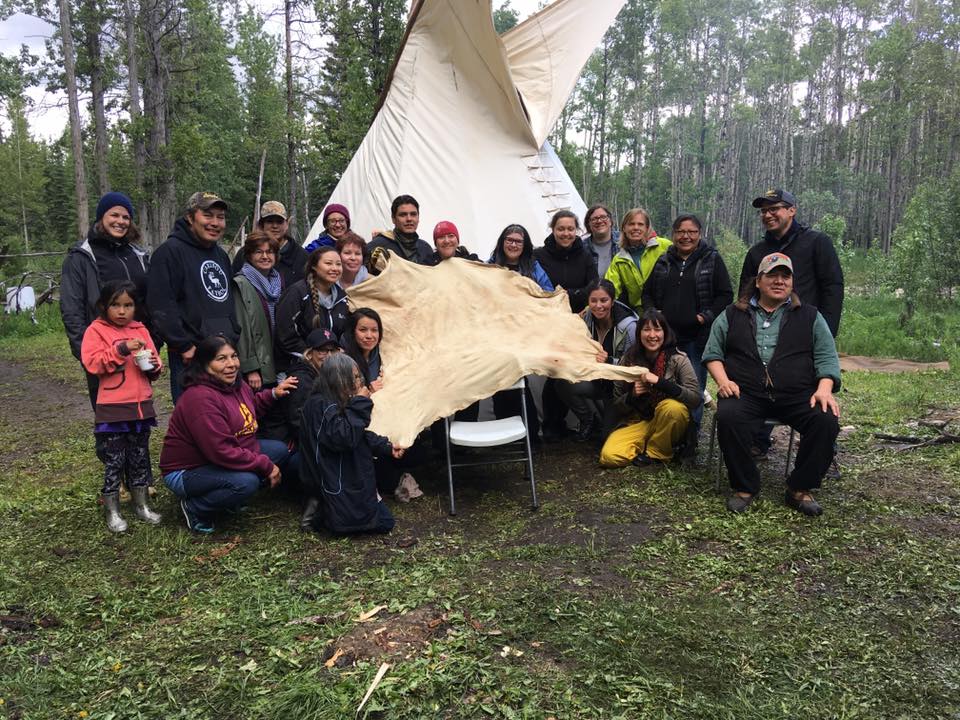
The completed moose hide prepared by the student participants in the Wahkohtowin Project in the Aseniwuche Winewak Nation in Susa Creek, Alberta
The University of Alberta's interdisciplinary Wahkohtowin Project delivered its first wilderness-based course, Wahkohtowin: Miyo-wîcêhtowin Principles and Practices, in June 2017 in the Aseniwuche Winewak Nation in Susa Creek, Alberta.
The for-credit course, co-instructed by UAlberta Law's Dr. Hadley Friedland and the Faculty of Native Studies' Dr. Shalene Jobin, was designed to impart students with knowledge and direct experience of the Cree legal and governance concepts of wahkohtowin and miyo-wîcêhtowin - terms that translate roughly as "interrelatedness" and "building good relations".
The course proved extremely impactful to all involved.
"Students and members of the community said numerous times that they found it 'life-changing' and 'transformative," said Jobin of the course.
The course was delivered over a four-day period from June 10 to 12 (with further in-class instruction at UAlberta) and involved a teaching team consisting of the course instructors as well as Elders and knowledge holders from Susa Creek near the town of Grande Cache. The focal point of the course was the traditional "brain-tanning" of a moose hide, a difficult, labor-intensive process that remains an important communal activity in many indigenous communities.
It takes a village
The Wahkohtowin Project was launched in October 2016 through a partnership between the University of Alberta Faculties of Law and Native Studies and the Susa Creek community, with funding provided by the office of the Provost and the Faculty of Graduate Studies' Indigenous Community Engagement, Research and Learning (CERL) fund.
The resultant course channeled the strengths of academic study and the traditional knowledge transmission modalities of the Cree Elders involved. Students prepared for the wilderness component of the course by way of preparatory reading, several written assignments (including reflexive journalling), and two full days of seminar classes delivered by Drs. Friedland and Jobin.
Following the four-day on-the-land component, which also included a round dance, traditional storytelling, lessons in foraging for edible plants (which culminated in making buffalo berry ice cream), students returned to the classroom on June 14 for an "integration seminar" wherein they shared their new understandings of the concepts of wahkohtowin and miyo-wîcêhtowin. Students also produced a photo-journal assignment documenting the experience, to be gifted to the community.
Notably, the real stars of the photo-journal assignment were the youth volunteers from the community who were paired with the UAlberta students as part of the course.
"The local youth proved to be some of the best teachers we could have had," said Friedland.
"Everyone from toddlers to teenagers got involved, and their patience, warmth, good humour and pride in their cultural knowledge was truly infectious."
Lasting connections
While the wilderness-based component of the course was only four days long, many of the connections it fostered promise to be long-lasting.
In September of this year there will be a memorial round dance in Grande Cache in memory of two beloved, recently passed Elders, and already the community has extended invitations to the Wahkohtowin Project students.
"They specifically asked me to extend an invitation via their Facebook group," said Friedland.
"We're also hoping some of the Aseniwuche Winewak youth will join us in September on the occasion of the Reconciliation/Wahkotowin Conference (September 21-23, 2017) to present the photo-journal project."
After a resoundingly successful inaugural course, Friedland and her colleagues are optimistic that it will continue to be offered for years to come.
"It surpassed my expections on every level," she remarked.
To see more highlights of the project, see this Facebook gallery.
In Gratitude
There are many people who made this course possible, including graduate students Tara Kappo and Renee McBeth for their tireless work and teaching and organizational roles, Kirsten Lindquist and Bev Findlay from the Faculty of Native Studies for essential administrative support, Professors Matt Wildcat and Matthew Lewans and our deans and associate deans for their support and encouragement.
The community based teaching team, which included Community Coordinator Ken McDonald; Elders Adelaide McDonald, Mabel Wanyandie, Dorothy Karakuntie, Philomene Moberly, Russell Wanyandie and Norman McDonald; and helpers: Alice Moberly, Yvonne MacPhee, Robert Wanyandie, Vicky Wanyandie, Carol Wanyandie and Danny McDonald were also truly invaluable, as were chefs and kitchen helpers Sandra Moberly, Brenda Moberly and Marianne Moberly.
Lastly, the James Gang Drummers, who sang for the rounddance and the closing circle, Aseniwuche Winewak Nation President David MacPhee (who welcomed everyone to the territory and gave teachings to the students) and Mountain Métis President Alvin Findley, who made sure Camp Hideaway was ready to use, made enormous contributions to the project.